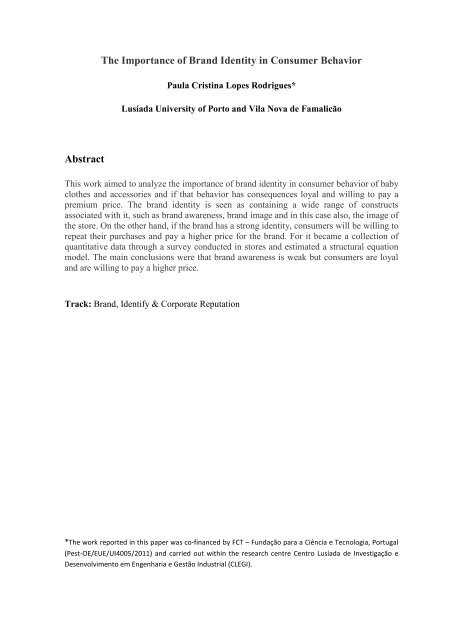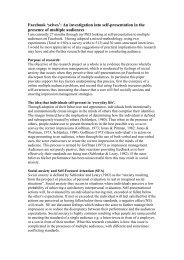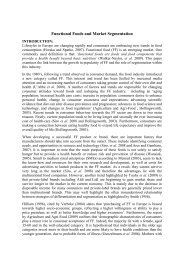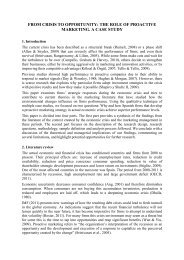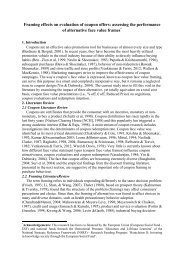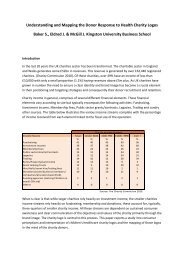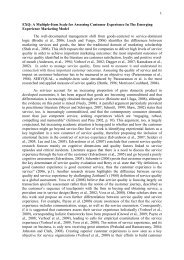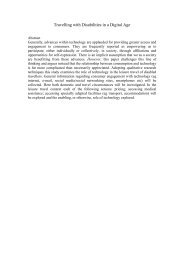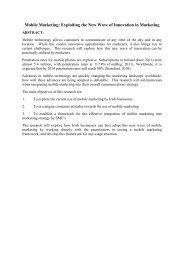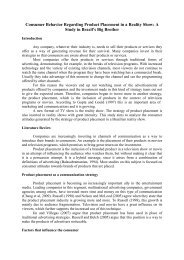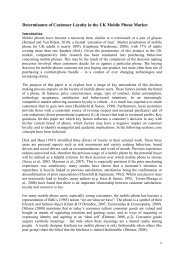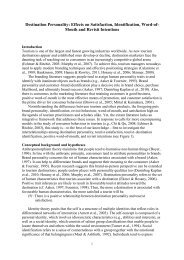The Importance of Brand Identity in Consumer Behavior Abstract
The Importance of Brand Identity in Consumer Behavior Abstract
The Importance of Brand Identity in Consumer Behavior Abstract
Create successful ePaper yourself
Turn your PDF publications into a flip-book with our unique Google optimized e-Paper software.
<strong>Abstract</strong><br />
<strong>The</strong> <strong>Importance</strong> <strong>of</strong> <strong>Brand</strong> <strong>Identity</strong> <strong>in</strong> <strong>Consumer</strong> <strong>Behavior</strong><br />
Paula Crist<strong>in</strong>a Lopes Rodrigues*<br />
Lusíada University <strong>of</strong> Porto and Vila Nova de Famalicão<br />
This work aimed to analyze the importance <strong>of</strong> brand identity <strong>in</strong> consumer behavior <strong>of</strong> baby<br />
clothes and accessories and if that behavior has consequences loyal and will<strong>in</strong>g to pay a<br />
premium price. <strong>The</strong> brand identity is seen as conta<strong>in</strong><strong>in</strong>g a wide range <strong>of</strong> constructs<br />
associated with it, such as brand awareness, brand image and <strong>in</strong> this case also, the image <strong>of</strong><br />
the store. On the other hand, if the brand has a strong identity, consumers will be will<strong>in</strong>g to<br />
repeat their purchases and pay a higher price for the brand. For it became a collection <strong>of</strong><br />
quantitative data through a survey conducted <strong>in</strong> stores and estimated a structural equation<br />
model. <strong>The</strong> ma<strong>in</strong> conclusions were that brand awareness is weak but consumers are loyal<br />
and are will<strong>in</strong>g to pay a higher price.<br />
Track: <strong>Brand</strong>, Identify & Corporate Reputation<br />
*<strong>The</strong> work reported <strong>in</strong> this paper was co-f<strong>in</strong>anced by FCT – Fundação para a Ciência e Tecnologia, Portugal<br />
(Pest-OE/EUE/UI4005/2011) and carried out with<strong>in</strong> the research centre Centro Lusíada de Investigação e<br />
Desenvolvimento em Engenharia e Gestão Industrial (CLEGI).
1. <strong>Brand</strong> <strong>Identity</strong><br />
<strong>The</strong> brand is an asset <strong>of</strong> the company that has ga<strong>in</strong>ed <strong>in</strong>creas<strong>in</strong>g importance and<br />
thus has <strong>in</strong>creas<strong>in</strong>gly captured the attention <strong>of</strong> managers. <strong>The</strong> American Market<strong>in</strong>g<br />
Association def<strong>in</strong>es a brand as the name, term, sign, symbol or design that identifies the<br />
goods or services <strong>of</strong> one seller or group <strong>of</strong> sellers and to differentiate them from their<br />
competitors. <strong>The</strong> brand concept is just so much more comprehensive than its graphical<br />
representation (Morgan and Rego, 2009; Keller and Lehmann, 2006, Aaker, 1996; Aaker<br />
and Joachimsthaler, 2000; Keller, 1993; Chernatony and McDonald, 2003; Kapferer,<br />
1997), compris<strong>in</strong>g a range <strong>of</strong> <strong>in</strong>tangible variables.<br />
<strong>The</strong> role <strong>of</strong> brands is to help ensure the company's identity. <strong>The</strong> identification <strong>of</strong> a<br />
brand, is a recognition factor and learn<strong>in</strong>g, which will translate to certa<strong>in</strong> consumer<br />
behavior (Morgan and Rego, 2009). <strong>Consumer</strong>s will together with their past experience <strong>in</strong><br />
brand awareness, acquir<strong>in</strong>g brands that meet their needs and desires.<br />
In order to understand the effect that the brand identity has on consumers, the<br />
consistency <strong>of</strong> identity with the brand concept has to be emphasized through the company's<br />
strategic options. This will facilitate the recognition and brand recall by consumers <strong>in</strong> an<br />
environment where there are multiple competitive options (Sonnier and A<strong>in</strong>slie, 2011).<br />
<strong>The</strong> consistency <strong>of</strong> the brand concept must stand the test <strong>of</strong> time, lead<strong>in</strong>g to the creation <strong>of</strong><br />
an identity. <strong>The</strong>re should be a consistent <strong>in</strong>crease dur<strong>in</strong>g a prolonged period, the strategies<br />
for creat<strong>in</strong>g the concept <strong>of</strong> brand, to keep the connection between identity and brand image<br />
(Chernatony and McDonald, 2003; Kapferer, 1997; Keller, 1993, 1998; Aaker and<br />
Joachimsthaler, 2000; Carrilat et. al., 2011; Monga and John, 2010; Batra et. al., 2010;<br />
Janonis et. al., 2007; Fischer et. al., 2010; Sonnier and A<strong>in</strong>slie, 2011).<br />
Thus, as the brand concept is understood as a name, a symbol, an image, it<br />
produces the identity recognition. By identity, the consumer is <strong>in</strong>fluenced <strong>in</strong> the decision to<br />
purchase the brand. <strong>The</strong> brand identity adds a set <strong>of</strong> associations and images that allows the<br />
consumer to recognize it and consider it <strong>in</strong> their decision process.<br />
<strong>The</strong> management literature def<strong>in</strong>es brand identity as the set <strong>of</strong> mean<strong>in</strong>gs by which a<br />
society allows itself to be known, and through which allows people to describe, remember<br />
and relate to it (Melewar et. al., 2005). Companies use the brand identity, to send a visual<br />
and verbal message to the market on its strategic position<strong>in</strong>g and to dist<strong>in</strong>guish it from<br />
competition (Melewar et. al., 2005; Aaker, 2004; Berens et. al., 2005; Martínez e P<strong>in</strong>a,<br />
2005). Also, Faust and Eilertson (1994) suggest that brand identity is much more than a<br />
symbol - is the name, is the personality, is the image and a whole host <strong>of</strong> other attributes<br />
that characterize the company and its products.<br />
In this work, the brand identity is operationalized as the brand image <strong>in</strong> consumers'<br />
m<strong>in</strong>ds, which allows the company to obta<strong>in</strong> loyal and will<strong>in</strong>g to pay a price premium for<br />
the brand. Like the first hypothesis is that the brand identity and determ<strong>in</strong>es loyal<br />
customers will<strong>in</strong>g to pay more for brand. <strong>The</strong> identity and brand image must be well<br />
def<strong>in</strong>ed, with the aim to identify the consumer to know and choose the product that meets<br />
their needs <strong>in</strong> full. It was developed a large number <strong>of</strong> studies on the brand image<br />
*<strong>The</strong> work reported <strong>in</strong> this paper was co-f<strong>in</strong>anced by FCT – Fundação para a Ciência e Tecnologia, Portugal<br />
(Pest-OE/EUE/UI4005/2011) and carried out with<strong>in</strong> the research centre Centro Lusíada de Investigação e<br />
Desenvolvimento em Engenharia e Gestão Industrial (CLEGI).
(Birtwistle et. al., 1999; Chowdhury et. al., 1998; Dutton et.al., 1994; Mart<strong>in</strong>ez et. at.,<br />
2005; Nandan, 2005; Batra and Homer, 2004; Martínez and Chernatony, 2004). <strong>Brand</strong><br />
image refers to the perception and the belief set <strong>of</strong> the brand by the consumer.<br />
0).<br />
H1: the brand identity provides loyal customers (β11 >0);<br />
H2: the brand identity provides customers will<strong>in</strong>g to pay more for the brand (β21 ><br />
In order to build and ma<strong>in</strong>ta<strong>in</strong> brand loyalty, it is imperative that the identity and<br />
brand image are congruent <strong>in</strong> order to translate value for the company as well as for<br />
consumers. <strong>The</strong> l<strong>in</strong>ks between the brand and the consumer must be established through<br />
<strong>in</strong>teractions that relate to consumer needs and motivations, based on the benefits provided<br />
by brand (Punniyamoorthy and Raj, 2007; Chaudhuri and Holbrook, 2001; Johnson et. al.,<br />
2006; Amraoui et. al., 2006; Kabiraj and Shanmugan, 2011).<br />
<strong>The</strong> price premium is the quality perceived by consumers, will<strong>in</strong>g to pay more for<br />
products with perceived quality, and consumers who trust, <strong>in</strong> comparison with other<br />
similar products, <strong>of</strong> lower value benefits (Bendapudi and Leone, 2002; Beatty and<br />
Rittet,1996; Dodds et. al., 1991; Apelbaum, et. al., 2003)<br />
<strong>The</strong> brand awareness is the brand value that reflects the memory <strong>of</strong> consumers, and<br />
it affects their behavior when the decision to buy (Peter and Olson, 2001; Macdonald and<br />
Sharp, 2000; Esch et. al., 2006; Naik et. al., 2008; Peter and Olson, 2001; Keller, 2003).<br />
<strong>The</strong>re is another hypothesis <strong>of</strong> the model, namely brand awareness helps build their<br />
identity.<br />
H3: brand awareness helps build their identity (γ11 >0).<br />
Has been <strong>in</strong>vestigated many facets <strong>of</strong> the construction <strong>of</strong> the store image, <strong>in</strong>clud<strong>in</strong>g<br />
its conceptualization and operationalization (Gardner et. al., 2001; Birtwisthe et. al., 1999;<br />
Dodds et. al., 1991; Doyle and Fenwick, 1974-75; Osman, 1993; Poter and Clacomb, 1997;<br />
Steenkamp and Wedel, 1991; Chawdhury et. al., 1998; Coll<strong>in</strong>s-Dodd and L<strong>in</strong>dley, 2003;<br />
Hartman and Spiro, 2005; Morschett et. al., 2005). <strong>The</strong> current literature states that store<br />
image is anyth<strong>in</strong>g from the perception <strong>of</strong> a store <strong>in</strong> the m<strong>in</strong>d <strong>of</strong> the consumer, and is a<br />
reflection <strong>of</strong> the attitude <strong>of</strong> consumers to the store. So we formulate the third hypothesis <strong>of</strong><br />
the model that says the store image helps build brand identity.<br />
H4: the store image helps build brand identity (γ12 >0).<br />
2. <strong>Brand</strong> <strong>Identity</strong> and <strong>Consumer</strong> <strong>Behavior</strong><br />
<strong>The</strong> Caracol <strong>Brand</strong> produces and sells cloth<strong>in</strong>g, textiles and accessories childcare<br />
for babies and children. <strong>The</strong> company represents and distributes exclusively <strong>in</strong> Portugal,<br />
different brands that complement each other <strong>in</strong> the universe <strong>of</strong> the child.<br />
*<strong>The</strong> work reported <strong>in</strong> this paper was co-f<strong>in</strong>anced by FCT – Fundação para a Ciência e Tecnologia, Portugal<br />
(Pest-OE/EUE/UI4005/2011) and carried out with<strong>in</strong> the research centre Centro Lusíada de Investigação e<br />
Desenvolvimento em Engenharia e Gestão Industrial (CLEGI).
In this work it was decided to for a structured questionnaire with Likert scales <strong>of</strong><br />
five po<strong>in</strong>ts. It was used a convenience sample because respondents were <strong>in</strong>dividuals who<br />
entered the shops <strong>of</strong> "Caracol <strong>Brand</strong>" dur<strong>in</strong>g the month <strong>of</strong> December 2010.<br />
With the data collected <strong>in</strong> the survey (n = 135), was performed a summary analysis<br />
<strong>of</strong> demographic characteristics <strong>of</strong> respondents. Thus, respondents who visited the stores<br />
“Caracol <strong>Brand</strong>” are predom<strong>in</strong>antly female, are mostly <strong>in</strong> the age group between 25 to 35<br />
years old, most heve an <strong>in</strong>come over one thousand euros and have a high school. Scales<br />
were used to measure consumer perceptions <strong>of</strong> "Caracol <strong>Brand</strong>" on items such as brand<br />
awareness (BA), brand image (BI), brand loyalty (BL), the will<strong>in</strong>gness to pay a price<br />
premium for the brand (PP) and the store image (SI). <strong>The</strong> scales for each <strong>of</strong> the items were<br />
collected from academic literature, hav<strong>in</strong>g already been validated. Data collection for the<br />
model estimation was done through a consumer survey us<strong>in</strong>g the scales <strong>of</strong> brand awareness<br />
from Yoo, et. al. (2000), scales <strong>of</strong> loyalty from Yoo and Donthu (2001), scales <strong>of</strong> price<br />
premium from Chauduri e Halbrook (2001), scales <strong>of</strong> brand image from Netemeyer, et. al<br />
(2004) and scales <strong>of</strong> store image from Poter and Clacomb (1997).<br />
Here are two phases to select and access<strong>in</strong>g end items that are used for the relevant<br />
constructs. First performed us<strong>in</strong>g an exploratory factor analysis <strong>of</strong> all variables, <strong>in</strong> order to<br />
verify, to the reality <strong>in</strong> question, it makes sense to keep the scales without any adjustment.<br />
<strong>The</strong> method <strong>of</strong> extraction <strong>of</strong> the factors was the "pr<strong>in</strong>cipal components". After an analysis<br />
is made <strong>of</strong> the reliability analysis <strong>of</strong> items us<strong>in</strong>g Cronbach's alpha coefficient. Items were<br />
removed from the scales <strong>of</strong> brand awareness, brand loyalty and store image and the results<br />
<strong>of</strong> the scales improved significantly. Likewise, we proceeded to obta<strong>in</strong> a new <strong>in</strong>dicator <strong>of</strong><br />
reliability.<br />
<strong>Brand</strong><br />
Awareness<br />
Table Summary <strong>of</strong> Factor Analysis and Reliability Analysis<br />
Factors/Itens Eigenvalues<br />
Variance<br />
Expla<strong>in</strong>ed<br />
Cronbach's<br />
alpha<br />
Number<br />
Itens<br />
1 2,386 79,548% 0,871 3<br />
<strong>Brand</strong> <strong>Identity</strong> 1 3,543 70,857% 0,896 5<br />
<strong>Brand</strong> Loyalty 1 3,750 75,003% 0,916 5<br />
Price Premium 1 2,394 79,811% 0,873 3<br />
Image Store 1 2,971 74,274% 0,883 4<br />
After exam<strong>in</strong><strong>in</strong>g the concepts <strong>of</strong> measurement scales have been carried out,<br />
<strong>in</strong>tended to establish a cause and effect relationship between variables. For this, it was<br />
applied the model through a structural equation analysis.<br />
*<strong>The</strong> work reported <strong>in</strong> this paper was co-f<strong>in</strong>anced by FCT – Fundação para a Ciência e Tecnologia, Portugal<br />
(Pest-OE/EUE/UI4005/2011) and carried out with<strong>in</strong> the research centre Centro Lusíada de Investigação e<br />
Desenvolvimento em Engenharia e Gestão Industrial (CLEGI).
<strong>The</strong> confirmatory measure model determ<strong>in</strong>es the way how the latent variables are<br />
measured. To analyse the goodness <strong>of</strong> fit, the chosen <strong>in</strong>dicators are the ones suggested by<br />
Hair et. al. (2006) as be<strong>in</strong>g the better absolute <strong>in</strong>dicators about goodness <strong>of</strong> fit, Chi-square,<br />
RMSEA (Root Mean Square Error <strong>of</strong> Approximation) and GFI (Goodness-<strong>of</strong>-Fit). Chisquare<br />
distribution is used to assess the sensibility <strong>of</strong> the test to sample dimension (n=<br />
272). Chi-square distribution presents acceptable values when this is <strong>in</strong>cluded between 1<br />
and 3 (Hair, et. al., 2006). It used the RMSEA (Root Mean Square Error <strong>of</strong><br />
Approximation) <strong>in</strong>stead <strong>of</strong> RMSSR (Root Mean Square Residual) because the model basis<br />
is estimated on data covariance matrix. This <strong>in</strong>dicator must be situated between and<br />
<strong>in</strong>clud<strong>in</strong>g the values <strong>of</strong> 0,05 (good adjustment) and 0,08 (acceptable adjustment). GFI<br />
(Goodness-<strong>of</strong>-Fit) is an <strong>in</strong>dex <strong>of</strong> the goodness <strong>of</strong> fit that represents the total degree <strong>of</strong><br />
adjustment, without one correction relatively to the degrees <strong>of</strong> freedom <strong>of</strong> the models. In<br />
the model <strong>of</strong> estimated measure by confirmatory factor analysis, values above 0,9 were<br />
obta<strong>in</strong>ed lead<strong>in</strong>g to the conclusion that it had a good adjustment.<br />
After the stabilisation <strong>of</strong> the model <strong>of</strong> measurement and the analysis <strong>of</strong> the quality<br />
<strong>of</strong> the adjustment, it has verified whether the hypotheses <strong>of</strong> research were confirmed or<br />
not. In the case <strong>of</strong> the model proposed, estimation was carried by the method <strong>of</strong> the<br />
maxime likelihood (ML), so that we could meet the objective <strong>of</strong> develop<strong>in</strong>g and test<strong>in</strong>g the<br />
theory about the brand identity. <strong>The</strong> analysis <strong>of</strong> quality <strong>in</strong>dicators <strong>of</strong> adjustment show that<br />
the model present values for all <strong>of</strong> them, lead<strong>in</strong>g to the conclusion that a good adjustment<br />
is verified.<br />
Structural Model Estimated<br />
Ma<strong>in</strong> Hypotheses Parameter Estimated p-<br />
Value<br />
<strong>Brand</strong> Awareness → <strong>Brand</strong> <strong>Identity</strong> (+)<br />
Store Image → <strong>Brand</strong> <strong>Identity</strong> (+)<br />
<strong>Brand</strong> <strong>Identity</strong> → <strong>Brand</strong> Loyalty (+)<br />
<strong>Brand</strong> <strong>Identity</strong> → Price Premium (+)<br />
χ 2 Normalised<br />
RMSEA<br />
GFI<br />
AGFI<br />
Conclusion<br />
*<strong>The</strong> work reported <strong>in</strong> this paper was co-f<strong>in</strong>anced by FCT – Fundação para a Ciência e Tecnologia, Portugal<br />
(Pest-OE/EUE/UI4005/2011) and carried out with<strong>in</strong> the research centre Centro Lusíada de Investigação e<br />
Desenvolvimento em Engenharia e Gestão Industrial (CLEGI).<br />
γ11<br />
γ12<br />
β11<br />
β21<br />
Indicators <strong>of</strong> Adjustment<br />
0,108<br />
0,968<br />
0,892<br />
0,788<br />
2,179<br />
0,056<br />
0,923<br />
0,912<br />
0,000<br />
0,018<br />
0,000<br />
0,000<br />
Supported<br />
Supported<br />
Supported<br />
Supported
Conclusions<br />
<strong>The</strong> brand identity can be created <strong>in</strong> several ways. Any potential encounter with the<br />
brand - market<strong>in</strong>g <strong>in</strong>itiated or not - is the opportunity to change the mental representations<br />
<strong>of</strong> the same and the type <strong>of</strong> <strong>in</strong>formation that can appear <strong>in</strong> the memory <strong>of</strong> consumers. <strong>The</strong><br />
presence <strong>of</strong> the brand with a strong reputation and a strong store image <strong>in</strong>fluences the<br />
creation <strong>of</strong> brand identity, which <strong>in</strong> turn determ<strong>in</strong>es the process <strong>of</strong> consumer choice. It was<br />
found that store image is quite significant and that helps <strong>in</strong> build<strong>in</strong>g brand identity. On the<br />
other hand, the consumer tends to become loyal and not very sensitive to higher prices <strong>of</strong><br />
the product analyzed. In future work should consider a more appropriate way other<br />
relevant components <strong>in</strong> brand management, such as perceived quality.<br />
With this study, it is concluded that an important part <strong>of</strong> creat<strong>in</strong>g a strong brand<br />
identity depends on the store image. Thus, <strong>in</strong> the elaboration <strong>of</strong> communication and<br />
market<strong>in</strong>g strategies, one cannot neglected the aspects <strong>of</strong> the place where the brands it<br />
sells.<br />
In conclusion, the academic research <strong>of</strong> brand has practical value <strong>of</strong> connect<strong>in</strong>g<br />
with <strong>in</strong>tellectual precision. Captur<strong>in</strong>g and synthesiz<strong>in</strong>g the complexity <strong>of</strong> knowledge and<br />
brand identity, and how the concepts change, as well as the <strong>in</strong>fluences, the market<strong>in</strong>g<br />
activities, provide tremendous changes and opportunities that can improve the theory <strong>of</strong><br />
consumer behavior and improve the practice <strong>of</strong> brand management.<br />
Future works should be conducted to determ<strong>in</strong>e if the store image, <strong>in</strong> another<br />
product category, have or not the same importance <strong>in</strong> creat<strong>in</strong>g brand identity.<br />
*<strong>The</strong> work reported <strong>in</strong> this paper was co-f<strong>in</strong>anced by FCT – Fundação para a Ciência e Tecnologia, Portugal<br />
(Pest-OE/EUE/UI4005/2011) and carried out with<strong>in</strong> the research centre Centro Lusíada de Investigação e<br />
Desenvolvimento em Engenharia e Gestão Industrial (CLEGI).
References<br />
Aaker, D.A, (1996), Build<strong>in</strong>g Strong <strong>Brand</strong>s, Free Press, N.Y.<br />
Aaker, D.A. and Joachimsthaler, E. (2000), <strong>Brand</strong> Leadership, New York: Free Press.<br />
Aaker, D. A. (2004), ‘Leverag<strong>in</strong>g the corporate brand’, California Management Review,<br />
Vol. 46, pp. 6 – 18.<br />
Amraoui, Leila e Dagoberto Páramo Morales (2006), “Relación entre el riesgo y la<br />
confianza en la marca. Estudio exploratorio en Francia”, Pensamiento y Gestión, Nº 20, pp.<br />
216-237.<br />
Apelbaum, Eidan, Gerstern Eitan and A. Naik Prasad (2003), “<strong>The</strong> Effects <strong>of</strong> Expert<br />
Quality Evaluations versus <strong>Brand</strong> Name on Price Premiums”, Journal <strong>of</strong> Product and<br />
<strong>Brand</strong> Management, Vol. 12, Nº 3, pp. 154-165.<br />
Batra, Rajaev and Pamela M. Homer (2004), “<strong>The</strong> Situational Impact <strong>of</strong> <strong>Brand</strong> Image<br />
Beliefs”, Journal <strong>of</strong> <strong>Consumer</strong> Psychology, Vol. 14, Nº 3; pp. 318-330.<br />
Batra, Rajeev; Lenk, Peter; Wedel, Michel (2010), “<strong>Brand</strong> Extension Strategy Plann<strong>in</strong>g:<br />
Empirical Estimation <strong>of</strong> <strong>Brand</strong>-Category Personality Fit and Atypicality”, Journal <strong>of</strong><br />
Market<strong>in</strong>g Research, Vol. 47, Nº 2, pp. 335-347.<br />
Bendapudi, N. and Leone, R. P. (2002), ‘Manag<strong>in</strong>g bus<strong>in</strong>ess-to-bus<strong>in</strong>ess customer<br />
relationships follow<strong>in</strong>g key contact employee turnover <strong>in</strong> a vendor firm’, Journal <strong>of</strong><br />
Market<strong>in</strong>g, Vol. 66, pp. 83 – 101.<br />
Berens, G., van Riel, C. B. M. and van Bruggen ,G. H. (2005), “Corporate associations and<br />
consumer product responses: <strong>The</strong> moderat<strong>in</strong>g role <strong>of</strong> corporate brand dom<strong>in</strong>ance”, Journal<br />
<strong>of</strong> Market<strong>in</strong>g, Vol. 69, Nº. 3, pp. 35 – 48.<br />
Beatty, R. and Ritter, J. (1986) ‘Investment bank<strong>in</strong>g, reputation and under pric<strong>in</strong>g <strong>of</strong> <strong>in</strong>itial<br />
public <strong>of</strong>fer<strong>in</strong>gs’, Journal <strong>of</strong> F<strong>in</strong>ancial Economics, Vol. 15, Nº 1, pp. 213–232.<br />
Birtwistle, G., Clarke, I. and Freathy, P. (1999), “Store image <strong>in</strong> the UK fashion sector:<br />
consumer versus retailer perceptions”, <strong>The</strong> International Review <strong>of</strong> Retail, Distribution and<br />
<strong>Consumer</strong> Research, Vol. 9, Nº1, pp. 1–16.<br />
Carrilat, François A.; Harris, Eric G.; Lafferty Barbara A. (2011), “Fortuitous <strong>Brand</strong> Image<br />
Transfer”, Journal <strong>of</strong> Advertis<strong>in</strong>g, Vol. 39, Nº 2, pp. 109-123.<br />
Chaudhuri, A. e M. B. Holbrook (2001), “<strong>The</strong> Cha<strong>in</strong> <strong>of</strong> Effects from <strong>Brand</strong> Trust and<br />
<strong>Brand</strong> Affect to <strong>Brand</strong> Performance: <strong>The</strong> Role <strong>of</strong> <strong>Brand</strong> Loyalty”, Journal <strong>of</strong> Market<strong>in</strong>g,<br />
Vol. 65, Nº 2, pp. 81-93.<br />
Chernatony, L. e McDonald, M (2003), Great<strong>in</strong>g Powerful <strong>Brand</strong>s, 3ª Ed., Oxford,<br />
Elsevier.<br />
*<strong>The</strong> work reported <strong>in</strong> this paper was co-f<strong>in</strong>anced by FCT – Fundação para a Ciência e Tecnologia, Portugal<br />
(Pest-OE/EUE/UI4005/2011) and carried out with<strong>in</strong> the research centre Centro Lusíada de Investigação e<br />
Desenvolvimento em Engenharia e Gestão Industrial (CLEGI).
Chowdhury, Jh<strong>in</strong>uk, James Reardon, Rajesh Srivastava (1998), “Alternative Modes <strong>of</strong><br />
Measur<strong>in</strong>g Store Image: an empirical assessment <strong>of</strong> structured versus unstructured<br />
measures”, Journal <strong>of</strong> Market<strong>in</strong>g – <strong>The</strong>ory and Practice, Vol. 6, pp. 72-86.<br />
Coll<strong>in</strong>s-Dodd, C. e T. L<strong>in</strong>dley (2003), “Store <strong>Brand</strong>s and Retail Differentiation: the<br />
Influence <strong>of</strong> Store Image and Store <strong>Brand</strong> Attitude on Store Own <strong>Brand</strong> Perceptions”,<br />
Journal <strong>of</strong> Retail<strong>in</strong>g and <strong>Consumer</strong> Services, Vol. 10, Nº 6, pp. 345-352.<br />
Dutton , J. E ., Dukerich , J . M . and Harquail , C .V . (1994), “Organizational images and<br />
member identification”, Adm<strong>in</strong>istrative Science Quarterly, Vol. 39, pp. 239 – 263.<br />
Dodds, William B., Kent B. Monroe e Dhruv Grewal (1991), “Effects <strong>of</strong> Price, <strong>Brand</strong> and<br />
Store <strong>in</strong>formation on buyer’s Product Evaluations”, Journal <strong>of</strong> Market<strong>in</strong>g Research, Vol.<br />
XXVIII, August, pp. 307-319.<br />
Doyle, P. and Fenwick, I. (1974–1975), “How store image affects shopp<strong>in</strong>g habits <strong>in</strong><br />
grocery cha<strong>in</strong>s”, Journal <strong>of</strong> Retail<strong>in</strong>g, Vol. 50, Nº4, pp. 39–52.<br />
Esch, Franz-Rudolf, Tobias Langner, Bernd H. Schmitt, Patrick Geus (2006), “Are brands<br />
forever? How brand knowledge and relationships affect current and future purchases”,<br />
Journal <strong>of</strong> Product and <strong>Brand</strong> Management, Vol. 15, Nº 2, pp. 98-105.<br />
Faust, W. H. and Eilertson, A. (1994), “You ’ ve got a logo, you need a brand”, ABA<br />
Bank<strong>in</strong>g Journal, Vol. 86, pp. 86-88.<br />
Ficher, Marc; Volckner, Fraziska; Satller, Henrik (2010), “How Important are brands? A<br />
Gross – Category, Gross- Country Study”, Journal <strong>of</strong> Market<strong>in</strong>g Research, Vol. 47, Nº 5,<br />
pp. 823-839.<br />
Gehani, R. R. (2001), “Enhanc<strong>in</strong>g brand equity and reputational capital with enterprisewide<br />
complementary <strong>in</strong>novations”, <strong>The</strong> Market<strong>in</strong>g Management Journal, Vol. 1, Nº. 1, pp.<br />
35–48.<br />
Grubb, E. L. and Grathwohl, H. L. (1967), “<strong>Consumer</strong> self concept, symbolism and market<br />
behavior: A theoretical approach”, Journal <strong>of</strong> Market<strong>in</strong>g, Vol. 31, October, pp. 22–27.<br />
Hartman, Kather<strong>in</strong>e B. and Rosann L. Spiro (2005), “Recaptur<strong>in</strong>g Store Image <strong>in</strong><br />
Customer-Based Store Equity: a Construct Conceptualization”, Journal <strong>of</strong> Bus<strong>in</strong>ess<br />
Research, Vol. 58, Nº 8, pp. 1112-1120.<br />
Harris, F. and de Chernatony, L. (2001), “Corporate brand<strong>in</strong>g and corporate brand<br />
performance”, European Journal <strong>of</strong> Market<strong>in</strong>g, Vol. 35, pp. 441 – 456.<br />
Janonis, Vytautas; Dovalienè, Aistè, Virvilaitè, Reg<strong>in</strong>a (2007), “Relationship <strong>of</strong> <strong>Brand</strong><br />
<strong>Identity</strong> and Image”, Eng<strong>in</strong>eer<strong>in</strong>g Economics, Vol. 51, Nº 1, pp. 69-79.<br />
Jarratt, D. (1996), “A shopper taxonomy for retail strategy development”, <strong>The</strong><br />
International Review <strong>of</strong> Retail, Distribution and <strong>Consumer</strong> Research, Vol. 6, Nº 2, pp.<br />
196–215.<br />
*<strong>The</strong> work reported <strong>in</strong> this paper was co-f<strong>in</strong>anced by FCT – Fundação para a Ciência e Tecnologia, Portugal<br />
(Pest-OE/EUE/UI4005/2011) and carried out with<strong>in</strong> the research centre Centro Lusíada de Investigação e<br />
Desenvolvimento em Engenharia e Gestão Industrial (CLEGI).
Johnson, Michael D., Andreas Herrmann and Frank Huber (2006), “<strong>The</strong> Evolution <strong>of</strong><br />
Loyalty Intentions”, Journal <strong>of</strong> Market<strong>in</strong>g, Vol. 70, Nº 2, pp. 122-132.<br />
Kabiraj, Sajal and Shanmugan, Joghee (2011), “Development <strong>of</strong> Conceptual Framework<br />
for <strong>Brand</strong> Loyalty: A Euro-Mediterranean Perspective”, Journal <strong>of</strong> <strong>Brand</strong> Management,<br />
Vol. 18, Nº 4/5, pp. 285-299.<br />
Kapferer, J. N. (1997), Strategic <strong>Brand</strong> Management. Creat<strong>in</strong>g and Susta<strong>in</strong><strong>in</strong>g <strong>Brand</strong><br />
Equity Long Term, 2 nd Ed., Kogan Page, London, UK.<br />
Keller, K.L. (1998), Build<strong>in</strong>g <strong>Brand</strong> Equity, Prentice Hall, USA.<br />
Keller, K. L. (1993), “Conceptualiz<strong>in</strong>g, measur<strong>in</strong>g, and manag<strong>in</strong>g customer-based brand<br />
equity”, Journal <strong>of</strong> Market<strong>in</strong>g, Vol. 75, pp. 1–22.<br />
Keller, K. L. and Lehmann, D. R. (2006), “<strong>Brand</strong> and <strong>Brand</strong><strong>in</strong>g: Research f<strong>in</strong>d<strong>in</strong>gs and<br />
future priorities”, Market<strong>in</strong>g Science, Vol. 25, Nº 6, pp. 740-759.<br />
Kotler, P. (1998), ‘Market<strong>in</strong>g Management: “Analysis, Plann<strong>in</strong>g and Contro”, Prentice-<br />
Hall, Englewood Cliffs, NJ.<br />
Macdonald, Emma K. and Byron M. Sharp (2000), “<strong>Brand</strong> Awareness Effects on<br />
<strong>Consumer</strong> Decision Mak<strong>in</strong>g for a Common, Repeat Purchase Product: A Replication”,<br />
Journal <strong>of</strong> Bus<strong>in</strong>ess Research, Vol. 45, pp. 5-15.<br />
Marguiles, W. P. (1997) “Make the most <strong>of</strong> your corporate identity”, Harvard Bus<strong>in</strong>ess<br />
Review, Vol. 55, Nº. 4, pp. 61–77.<br />
Mart<strong>in</strong>ez, Eva and Leslie de Chernatony (2004), “<strong>The</strong> Effect <strong>of</strong> <strong>Brand</strong> Extension Strategies<br />
upon <strong>Brand</strong> Image”, Journal <strong>of</strong> <strong>Consumer</strong> Market<strong>in</strong>g, Vol. 21, Nº 1, pp. 39-50.<br />
Martínez , E . and P<strong>in</strong>a , J . M . (2005), “Influence <strong>of</strong> corporate image on brand extensions:<br />
A model applied to the service sector”, Journal <strong>of</strong> Market<strong>in</strong>g Communications, Vol. 11,<br />
pp. 263 – 281.<br />
Melewar, T. C. , Karaosmanoglu, E. and Paterson, D. (2005), “Corporate identity:<br />
Concept, components and contribution”, Journal <strong>of</strong> General Management , Vol. 31 , pp. 59<br />
– 81.<br />
Monga, Alokparna Basu and John, Deborah Roedder (2010), “What makes brands elastic?<br />
<strong>The</strong> <strong>in</strong>fluence <strong>of</strong> brand concept and styles <strong>of</strong> th<strong>in</strong>k<strong>in</strong>g on brand extension evaluation”,<br />
Journal <strong>of</strong> Market<strong>in</strong>g, Vol. 74, Nº 3, pp. 80-92.<br />
Morgan, Neil A. and Rego, Lopo L. (2009), “<strong>Brand</strong> Portfolio Strategy and Firm<br />
Performance”, Journal <strong>of</strong> Market<strong>in</strong>g, Vol. 73, pp. 59-74.<br />
Morschett, Dirk, Bernhard Swoboda and Thomas Foschht (2005), “Perception <strong>of</strong> Store<br />
Attributes and Overall Attitude towards Grocery Retailers: the Role <strong>of</strong> Shopp<strong>in</strong>g Motives”,<br />
*<strong>The</strong> work reported <strong>in</strong> this paper was co-f<strong>in</strong>anced by FCT – Fundação para a Ciência e Tecnologia, Portugal<br />
(Pest-OE/EUE/UI4005/2011) and carried out with<strong>in</strong> the research centre Centro Lusíada de Investigação e<br />
Desenvolvimento em Engenharia e Gestão Industrial (CLEGI).
International Review <strong>of</strong> Retail, Distribution and <strong>Consumer</strong> Research, Vol. 15, Nº 4, pp.<br />
423-447.<br />
Naik, Prasad A., Ashutosh Prasad and Suresh P. Sethi (2008), “Build<strong>in</strong>g <strong>Brand</strong> Awareness<br />
<strong>in</strong> Dynamic Oligopoly Markets”, Management Science, Vol. 54, Nº 1, pp. 129-138.<br />
Nandan, Shiva (2005), “An exploration <strong>of</strong> the brand identity-brand image l<strong>in</strong>kage: A<br />
communications perspective”, <strong>Brand</strong> Management, Vol. 12, Nº 4, pp. 264-278.<br />
Netemeyer, Richard G., Balaji Krishnan, Chris Pullig, Guangp<strong>in</strong>g Wang, Mehmet Yagci,<br />
Dwane Dean, Joe Ricks e Ferd<strong>in</strong>and Wirth (2004), “Develop<strong>in</strong>g and Validat<strong>in</strong>g Measures<br />
<strong>of</strong> Facets <strong>of</strong> Customer-Based <strong>Brand</strong> Equity”, Journal <strong>of</strong> Bus<strong>in</strong>ess Research, Vol. 57, Nº 2,<br />
pp. 209-224.<br />
Osman, M. Z. (1993), “A conceptual model <strong>of</strong> retail image <strong>in</strong>fluences on loyalty patronage<br />
behaviour”, <strong>The</strong> International Review <strong>of</strong> Retail, Distribution and <strong>Consumer</strong> Research, Vol.<br />
3, Nº2, pp. 133–148.<br />
Peter, J. Paul and Jerry C. Olson (2001), <strong>Consumer</strong> Behaviour, Chicago: Irw<strong>in</strong>.<br />
Porter, Stephen S. e C<strong>in</strong>dy Clacomb (1997), “<strong>The</strong> Influence <strong>of</strong> <strong>Brand</strong> Recognition on<br />
Retail Store Image”, Journal <strong>of</strong> Product and <strong>Brand</strong> Management, Vol. 6, Nº 6, pp. 373-<br />
387.<br />
Punniyamoorthy M. and M. Prasanna Mohan Raj (2007), “An empirical model for brand<br />
loyalty measurement”, Journal <strong>of</strong> Target<strong>in</strong>g, Measurement and Analysis for Market<strong>in</strong>g,<br />
Vol. 15, Nº 4, pp. 222 – 233.<br />
Russell, C. A. (2002), “Investigat<strong>in</strong>g the effectiveness <strong>of</strong> product placements <strong>in</strong> television<br />
shows: <strong>The</strong> role <strong>of</strong> modality and plot connection congruence on brand memory and<br />
attitude”, Journal <strong>of</strong> <strong>Consumer</strong> Research, Vol. 29, pp. 306–318.<br />
Sonnir, Garrett; A<strong>in</strong>slie, Andre W. (2011), “Estimat<strong>in</strong>g the value <strong>of</strong> <strong>Brand</strong>- Image<br />
Associations: the Role <strong>of</strong> General and Specific <strong>Brand</strong> Image”, Journal <strong>of</strong> Market<strong>in</strong>g<br />
Research, Vol. 48, Nº 3, pp.518-531.<br />
Steenkamp, J.-B. and Wedel, M. (1991), “Segment<strong>in</strong>g retail markets on store image us<strong>in</strong>g<br />
a consumer-based methodology”, Journal <strong>of</strong> Retail<strong>in</strong>g, Vol. 67, Nº 3, pp. 300–320.<br />
Yoo, Boonghee, Naveen Donthu e Sungho Lee (2000), “An Exam<strong>in</strong>ation <strong>of</strong> Selected<br />
Market<strong>in</strong>g Mix Elements and <strong>Brand</strong> Equity”, Journal <strong>of</strong> the Academy <strong>of</strong> Market<strong>in</strong>g<br />
Science, Vol. 28, Nº 2, pp. 197-213.<br />
*<strong>The</strong> work reported <strong>in</strong> this paper was co-f<strong>in</strong>anced by FCT – Fundação para a Ciência e Tecnologia, Portugal<br />
(Pest-OE/EUE/UI4005/2011) and carried out with<strong>in</strong> the research centre Centro Lusíada de Investigação e<br />
Desenvolvimento em Engenharia e Gestão Industrial (CLEGI).
*<strong>The</strong> work reported <strong>in</strong> this paper was co-f<strong>in</strong>anced by FCT – Fundação para a Ciência e Tecnologia, Portugal<br />
(Pest-OE/EUE/UI4005/2011) and carried out with<strong>in</strong> the research centre Centro Lusíada de Investigação e<br />
Desenvolvimento em Engenharia e Gestão Industrial (CLEGI).


